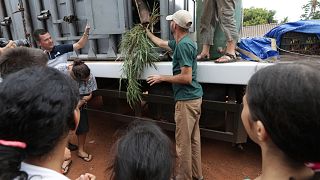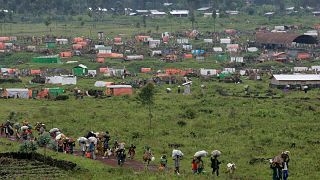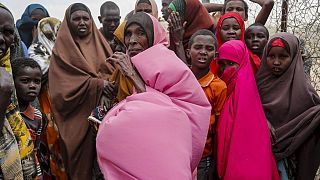Cocoa
Climate change is stressing rainforests where the highly-sensitive cocoa bean grows, but chocolate lovers need not despair, say companies that are researching other ways to grow cocoa or develop cocoa substitutes.
Advanced samples have already been created by agricultural/food scientists across the globe, from Northern California to the country of Israel.
California Cultured, a plant cell culture company, is growing cocoa from cell cultures at a facility in West Sacramento, with plans to start selling its products next year. It puts cocoa bean cells in a vat with sugar water so they reproduce quickly and reach maturity in a week rather than the six to eight months a traditional harvest takes, said Alan Perlstein, the company's chief executive. The process also no longer requires as much water or arduous labor.
"We trick basically the cocoa cells to grow and divide. And after a certain level of growth, we're able to harvest that and transform that into chocolate,” Perlstein said. "So climate change is impacting the chocolate industry by, first of all, making it too warm for many species to prosper. And that has led to massive drops in yield around the world."
Cocoa trees grow about 20 degrees north and south of the equator in regions with warm weather and abundant rain, including West Africa and South America. Climate change is expected to dry out the land under the additional heat. So scientists, entrepreneurs and chocolate-lovers are innovating ways to grow cocoa and make the crop more resilient and more resistant to pests _ as well as craft chocolatey-tasting cocoa alternatives to meet demand.
The market for chocolate in the United States and Europe is massive with sales surpassing $25 billion in 2023, according to the National Confectionary Association. Many entrepreneurs are betting on demand growing faster than the supply of cocoa. Companies are looking at either bolstering the supply with cell-based cocoa or offering alternatives made from products ranging from oats to carob that are roasted and flavored to produce a chocolatey taste for chips or filling.
The price of cocoa soared earlier this year because of demand and troubles with the crop in West Africa due to plant disease and changes in weather. The region produces the bulk of the world’s cocoa.
The innovation is largely driven by demand for chocolate in the United States and Europe, said Carla Martin, executive director of the Fine Cacao and Chocolate Institute and a lecturer in African and African American Studies at Harvard University. While three-quarters of the world's cocoa is grown in West and Central Africa, only 4% is consumed there, she said.
The push to produce cocoa indoors in the U.S. comes after other products, such as chicken meat, have already been grown in labs. It also comes as supermarket shelves fill with evolving snack options _ something that developers of cocoa alternatives say shows people are ready to try what looks and tastes like a chocolate chip cookie even if the chip contains a cocoa substitute.
They said they also are hoping to tap into rising consciousness among consumers about where their food comes from and what it takes to grow it, particularly the use of child labor in the cocoa industry.
Planet A Foods in Planegg, Germany contends the taste of mass market chocolate is derived largely from the fermentation and roasting in making it, not the cocoa bean itself. The company's founders tested out ingredients ranging from olives to seaweed and settled on a mix of oats and sunflower seeds as the best tasting chocolate alternative, said Jessica Karch, a company spokesperson. They called it “ChoViva” and it can be subbed into baked goods, she said.
Yet while some are seeking to create alternative cocoa sources and substitutes, others are trying to bolster the supply of cocoa where it naturally grows. Mars which makes M&Ms and Snickers has a research facility at University of California, Davis aimed at making cocoa plants more resilient, said Joanna Hwu, the company's senior director of cocoa plant science. The facility hosts a living collection of cocoa trees so scientists can study what makes them disease-resistant to help farmers in producing countries and ensure a stable supply of beans.
In Israel, efforts to expand the supply of cocoa are also under way. Celleste Bio is taking cocoa bean cells and growing them indoors to produce cocoa powder and cocoa butter, said co-founder Hanne Volpin. In a few years, the company expects to be able to produce cocoa regardless of the impact of climate change and disease _ an effort that has drawn interest from Mondelez, the maker of Cadbury chocolate.
That's similar to the effort under way at California Cultured, which plans to seek permission from the U.S. Food and Drug Administration to call its product chocolate, because, according to Perlstein, that's what it is.
It might wind up being called brewery chocolate, or local chocolate, but chocolate no less, he said, because it's genetically identical though not harvested from a tree.
"As climate change progresses, we're only going to see more threats to our supply chain. And so it's great to have the opportunity to produce things domestically and sustainably," Ashley Arnell, program manager at BioMADE, a nonprofit group helping California Cultured with its biomanufacturing system.











01:15
Morocco says 2024 was the hottest year with temperatures reaching 47.7 degrees
Go to video
In Ivory Coast, the world's largest cocoa producer, farmers worry over new US tariffs
Go to video
UK: Luxury Easter egg chocolatiers face squeeze from soaring cocoa prices
Go to video
Major nations agree on first global tax on shipping’s greenhouse gas emissions
01:41
Ocean carbon solutions face growth and environmental challenges
05:45
Study finds world's mountain glaciers melting faster than ever before